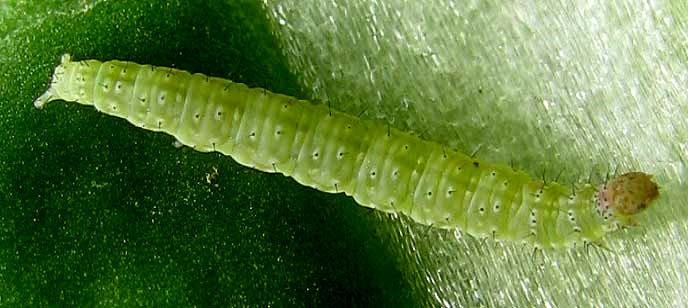Excerpts from Jim Conrad's
Naturalist Newsletter

from the March 10, 2013 Newsletter issued from the valley of the Dry Frio River in northern Uvalde County, southwestern Texas, on the southern border of the Edwards Plateau; elevation ~1750m (~5750 ft); N29.62°, W99.86°; USA
GREEN CATERPILLARS IN MUSTARD GREENS
Picking mustard greens, a little green caterpillar about 15mm long (5/8ths inch) turned up beneath a leaf, with a single strand of silk anchored on the leaf's surface next to him and crossing his back, as shown above. Volunteer identifier Bea in Ontario anguished over this one because there are so many little green caterpillars similar to this. However, in the end she decided:
"I can't see it being anything else other than the Hawaiian Beet Webworm! But for some reason there are very few pictures on the internet. The host plant is wrong but in more than one website I've read that they will eat other plants if the regular host plant is not available."
Therefore: Hawaiian Beet Webworm, SPOLADEA RECURVALIS, so widely distributed throughout the world's warmer parts that its original home is uncertain. It occurs all across the US, mostly in the southern states. The caterpillar's preferred food is plants of the Amaranth Family, which includes beets, spinach and chard but, as Bea points out, when those foods aren't available it'll eat other things.
Bea wanted to see larger, more mature caterpillars to confirm that it was a Hawaiian Beet Webworm, so I returned to the mustard greens. All I found, though, was a caterpillar even smaller than the previous one, maybe 5mm in length (3/16ths inch), so small I couldn't see any features other than its greenness. However, I got a picture, the one shown below, and sent it to Bea.

Bea's reply, which only a true-blooded identifier could have sent, was:
"OH my gosh, Jim! That's the Diamondback moth caterpillar (Plutella xylostella)..."
So, this second species of little green caterpillar eating my mustard greens is the Diamondback Moth caterpillar, PLUTELLA XYLOSTELLA, thought to be of European origin but now found throughout the Americas and in Europe, Southeast Asia, Australia, and New Zealand. In North America the species has been recorded wherever cabbage is grown, and that sounds about right since around Uvalde during the winter there are vast, circular, irrigated fields of commercially grown cabbage. The caterpillars don't eat only cabbage, though; they feed on practically all members of the Mustard Family, which besides cabbage includes broccoli, Brussels sprouts, Chinese cabbage, cauliflower, collards, kale, kohlrabi, mustard, radish, turnip, and watercress.